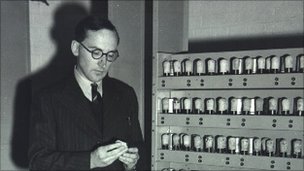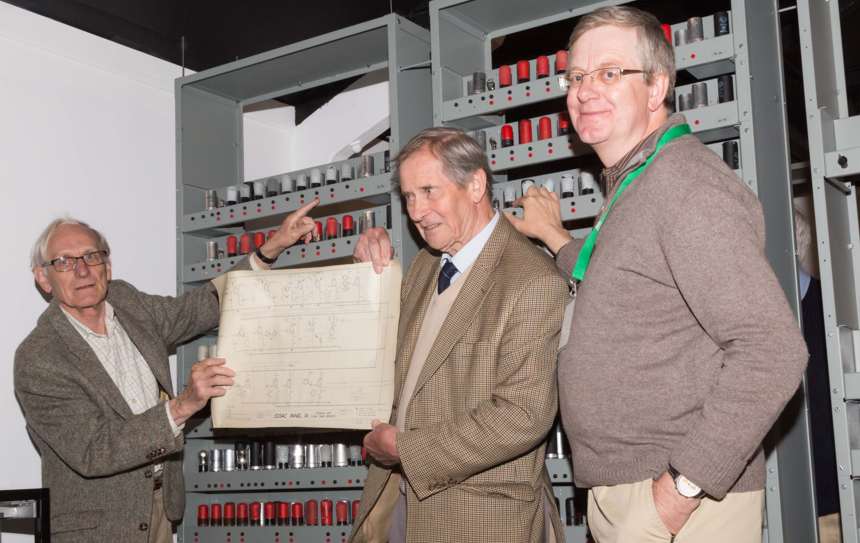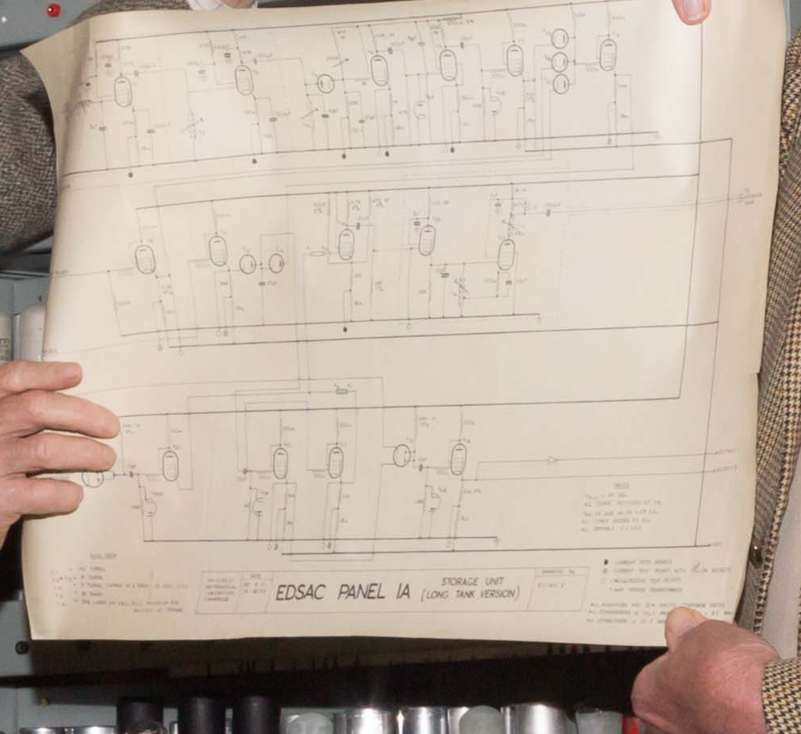| EDSAC Diagrams Rediscovered |
| Written by Sue Gee | |||
| Saturday, 28 June 2014 | |||
|
Circuit diagrams of EDSAC, the first general-purpose computer, have been donated to the team which is currently reconstructing the historic computer using incomplete evidence.
Maurice Wilkes and EDSAC
EDSAC, the Electronic Delay Storage Automatic Calculator, was originally built immediately after World War II by a team led by Sir Maurice Wilkes in the Mathematical Laboratory of the University of Cambridge, England. It was used by scientific researchers across the university, helping three of them to win Nobel Prizes. The EDSAC design was later used as the basis for LEO, the world's first business computer. Due to its importance in the history of computing the UK's Computer Conservation Society embarked on a 4-year project to build a replica of EDSAC as it was on 6th May 1949, when it ran its first ever program. This is taking place in full public gaze at the UK's National Museum of Computing (TNMOC) located in the grounds of Bletchley Park, Britain's wartime code-cracking centre and therefore the "home of computing" in the UK. In its heyday EDSAC was room-sized with over 120 two-meter high floor-standing chassis. By the time it was scrapped in the late 1950s, only three of these chassis survived. The rebuild is therefore having to recreate parts - although not always entirely authentic ones. The original EDSAC used mercury-filled tubes for memory, but in the interests of safety, the replica uses an alternative non-toxic substance. As this video from 2012 explains the main challenge facing the team of volunteers who are working on the rebuild is the lack of documentation. There are almost no original design documents remaining so the rebuild volunteers have to scrutinize photographs to puzzle out which bits go where.
However, three years into the project a set of 19 detailed circuit diagrams have come to light and been handed to the EDSAC team by John Loker a former engineer in the University of Cambridge Mathematical Laboratory. He explains: "I started work as an engineer in the Maths Lab in 1959 just after EDSAC had been decommissioned. In a corridor there was a lot of stuff piled up ready to be thrown away, but amongst it I spotted a roll of circuit diagrams for EDSAC. I'm a collector, so I couldn't resist the urge to rescue them. It wasn't until I visited TNMOC recently and learned about the EDSAC Project that I remembered I had the diagrams at home, so I retrieved them and gave them to the Project."
Chris Burton with John Loker and Andrew Herbert and one of the diagrams The diagrams date from between 1949 and 1953, were drawn after EDSAC had been constructed, probably as some sort of aid in refining the original machine and in designing the next. They seem to have been part of a much larger set numbering at least 150 and are in remarkably good condition.
(click in photo to enlarge)
In the main the documents confirm that the team has been correct in most of its re-engineering assumptions, but the drawings have thrown up a few surprises. Andrew Herbert, leader of the EDSAC Project, said: "Thankfully, the documents confirm that the reconstruction we are building is basically correct, but they are giving us some fascinating insights about how EDSAC was built and show that we are very much in tune with the original engineers: both teams have been exercised by the same concerns! "Importantly, the drawings clearly show that the aim of EDSAC's designer, Sir Maurice Wilkes, was to produce a working machine quickly rather than to create a more refined machine that would take longer to build. The refinements could come later -- and many did as the sequence of diagrams over the five-year period shows." The most significant discrepancy between the original and the reconstruction that the papers reveal is in the "initial orders" (boot ROM in modern terminology). In the absence of fuller information, the reconstruction team had considered and rejected one possibility which was in fact the one that was used by the original engineers. That will now be rectified in the reconstruction which is due for completion in later 2015.
More InformationRediscovered EDSAC diagrams reveal secrets Related ArticlesEDSAC Reconstruction Demoed To Celebrate Wilkes Centenary On this day in 1949 - EDSAC performs stored-program calculation Maurice Wilkes, father of British computing, dies
To be informed about new articles on I Programmer, install the I Programmer Toolbar, subscribe to the RSS feed, follow us on, Twitter, Facebook, Google+ or Linkedin, or sign up for our weekly newsletter.
Comments
or email your comment to: comments@i-programmer.info
|
|||
| Last Updated ( Thursday, 05 May 2022 ) |




